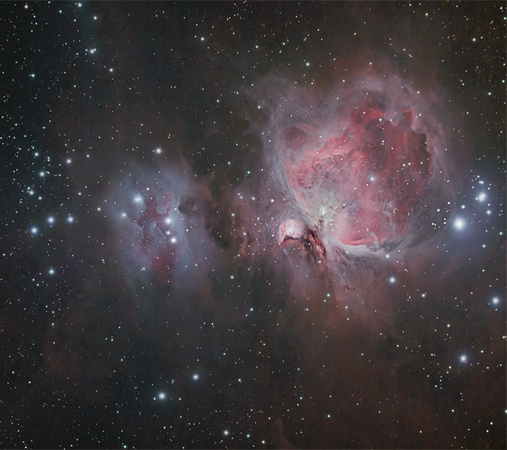Date: 1/15/2010
Target: M42 - Orion Nebula
Telescope: Vixen ED80Sf w/ WO 0.8x FR/FF
Camera: Canon 40D (modified)
Filter: Hutech IDAS LPS
Exposures: 10x120s, 10x30s, 10x5s, 44x300s (3.6h) @ ISO800
Framing: North is left
Start Temp: 31F
End Temp: 25F
Location: Mocksville, NC
Seeing: 3/5
Transparency: 4/5
FWHM: 9.76"
Start Time: 8:30PM
End Time: 2:00AM
Captured in Nebulosity, stacked using DeepSkyStacker, processed in Photoshop.
Winner - AstrophotoGallery.org Monthly Challenge January 2010Anacortes Telescope and Wild Bird Picture of the Day February 2, 2010Winner - Digital_Astro Monthly Challenge February 2010Featured on Vixen Optics ED80Sf Product Page (original) From
Wikipedia.org:
The
Orion Nebula (also known as
Messier 42,
M42, or
NGC 1976) is a
diffuse nebula situated south of
Orion's Belt. It is one of the brightest
nebulae, and is visible to the
naked eye in the night sky. M42 is located at a distance of 1,344 ± 20
light years and is the closest region of massive
star formation to
Earth. The M42 nebula is estimated to be 24 light years across. Older texts frequently referred to the Orion Nebula as the
Great Nebula in Orion or the
Great Orion Nebula.
The Orion Nebula is one of the most scrutinized and photographed objects in the night sky, and is among the most intensely studied celestial features. The nebula has revealed much about the process of how
stars and
planetary systems are formed from collapsing clouds of gas and dust. Astronomers have directly observed
protoplanetary disks,
brown dwarfs, intense and turbulent motions of the gas, and the
photo-ionizing effects of massive nearby stars in the nebula. There are also
supersonic "bullets" of gas piercing the dense hydrogen clouds of the Orion Nebula. Each bullet is ten times the diameter of
Pluto's orbit and tipped with iron atoms glowing bright blue. They were probably formed one thousand years ago from an unknown violent event.


